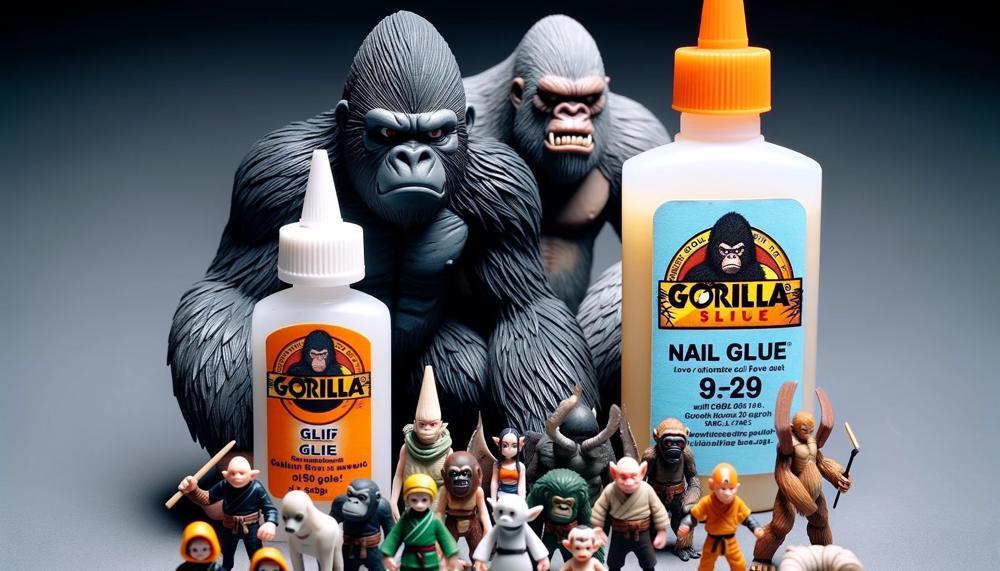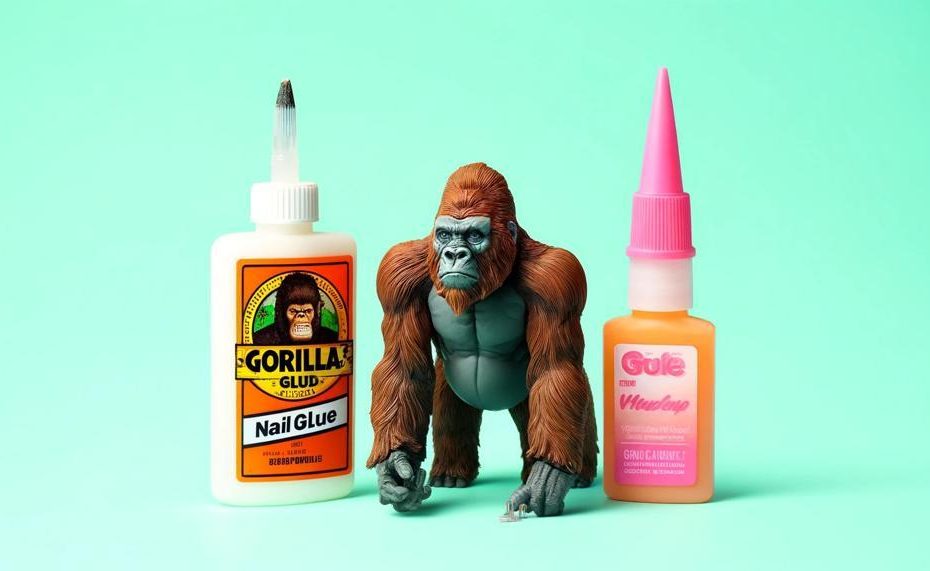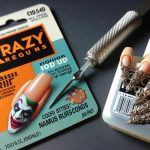Did you know that each year, emergency rooms in the United States see over 8,000 cases related to glue mishaps? Among these, a significant number involve the misuse of industrial glues on body parts such as fingers and nails.
When it comes to DIY beauty hacks, the choice of adhesive can not only affect the outcome but also your safety.
So, can i use gorilla glue instead of nail glue?
While Gorilla Glue is known for its strong bonding power, it’s not recommended to use it as a substitute for nail glue. Gorilla Glue tends to expand as it dries and can create bubbles. Moreover, it can cling to your nails for an uncomfortably long time.
There are safer alternatives to nail glue that you might want to consider. Some of these include nail tabs, gel polish, and acrylic mixtures. These alternatives are not only effective but also kinder to your nails. However, always ensure to check the ingredients and safety of the product before using it.
While the allure of using what you have on hand is strong, understanding the chemistry and consequences of adhesives can save you from a sticky situation. Let’s dive into why Gorilla Glue might not be your best option for that perfect nail job.
Table of Contents
What is Gorilla Glue?
Gorilla Glue is a renowned multi-purpose adhesive known for its incredible bonding strength and versatility. Unlike traditional adhesives, it is designed to bond dissimilar surfaces with a robust, long-lasting grip. Key characteristics include its water resistance, ability to fill gaps, and expand during the curing process to ensure a tight seal.
Predominantly used in woodworking, ceramics, and general repairs, Gorilla Glue is based on a polyurethane formula that requires moisture to activate.
Comparison between Gorilla Glue and Traditional Nail Glue:
| Attribute | Gorilla Glue | Traditional Nail Glue |
| Composition | Polyurethane | Cyanoacrylate |
| Primary Use | General repairs, woodworking, ceramics | Nail application (faux and acrylic nails) |
| Bonding Time | Instant bonding, cures fully in 24 hours | Instant bonding, designed for quick fixes |
| Strength | Extremely strong, can bond disparate materials | Strong but suitable for temporary bonding of nails only |
| Safety | Requires gloves, can bond skin | Safe for skin contact when used as directed |
| Removability | Difficult to remove, may require soaking and abrasion | Easier to remove, often with acetone or nail polish remover |
What is Nail Glue?
Nail glue is a specific type of adhesive formulated mainly from ethyl-2-cyanoacrylate, a kind of cyanoacrylate adhesive more commonly known as “super glue.”
It’s designed for bonding artificial enhancements like acrylic or gel nails to natural nails, and for repairing natural nails.
It is celebrated for its rapid bonding capabilities, which make it an indispensable tool in cosmetic nail applications.
Differences between Gorilla Glue and Nail Glue
The key differences between Gorilla Glue and Nail Glue primarily lie in their chemical composition, strength, and recommended applications, making each suited for specific tasks.
| Aspect | Gorilla Glue | Nail Glue |
| Composition | Polyurethane-based, which allows it to expand and form a strong bond with porous surfaces. | Cyanoacrylate-based, designed for fast setting and a rigid bond, suitable for non-porous materials. |
| Strength | Provides a very strong bond that makes it ideal for heavy-duty tasks and repairs on materials like wood, metal, and ceramics. | Offers a precise, quick-drying bond perfect for bonding small, delicate items such as artificial nails to natural nails. |
| Flexibility andamp; Usability | Expands as it cures, which can be useful for filling gaps. Not recommended for continuous exposure to water. | Less flexible, suitable for temporary fixes or small scale applications where adjustment time is minimal. |
| Cleaning andamp; Curing Time | Requires more effort to clean up; has a longer curing time which allows for repositioning if necessary. | Quick curing, which makes it less forgiving during application but easier for rapid repairs or applications. |
| Suitable Uses | Best for woodworking, construction, and heavy repairs where strength is paramount. | Ideal for cosmetic repairs, craft projects, and attaching lightweight materials where rapid setting is required. |
Gorilla Glue’s robust nature makes it perfect for enduring repairs or where a formidable bond is required, while Nail Glue’s swift bonding capacity is excellent for crafts and minor, fast fixes.
Advantages of Using Nail Glue over Gorilla Glue
| Feature | Nail Glue | Gorilla Glue |
| Suitability for Materials | Perfect for delicate and lightweight materials, often used in crafts and small home projects. | Designed for heavy-duty projects and stronger materials, potentially too robust for delicate tasks. |
| Curing Time | Starts curing within seconds, providing quick adhesion for rapid project progression. | Curing starts after 30 minutes, requiring longer wait times for project handling. |
| Clean-Up | Easier to remove from unintended surfaces, beneficial for projects needing neat finishes. | Requires more effort to clean, which can be cumbersome in projects needing precision. |
Choosing nail glue over Gorilla Glue offers several advantages depending on your project requirements. Nail glue’s superior suitability for delicate materials makes it the go-to choice for crafting and minor home improvement tasks, ensuring materials aren’t compromised by overly robust adhesives.
Its rapid curing time allows for swift progress, ideal when time is a constraint or when multiple pieces need quick assembly.
Additionally, the ease of cleanup with nail glue ensures that any spills or excess can be easily removed, preserving the cleanliness and integrity of the work surface.
Disadvantages of Using Gorilla Glue on Nails
Using Gorilla Glue on nails, rather than specialized nail glue, introduces several risks and drawbacks that could compromise both the health of the nail and overall safety.
Below is a detailed breakdown of these disadvantages:
| Risk | Explanation | Impact |
| Skin and Nail Damage | Gorilla Glue is not formulated for human skin or nails. It bonds too aggressively, leading to potential nail and surrounding skin damage when removed. | Can result in painful removal, potential for permanent nail damage, and unsightly appearance. |
| Fungal Infections | The swelling property of Gorilla Glue can trap moisture under the nail, creating an environment conducive to fungal growth. | Increases the risk of developing uncomfortable and often stubborn fungal infections. |
| Brittleness | Repeated use of Gorilla Glue on nails can lead to increased brittleness, making nails prone to breaking and splitting. | Nails become weaker and less flexible, leading to discomfort and potential injury. |
| Strong Odor and Chemical Burns | The chemical composition of Gorilla Glue includes substances that emit a strong odor and can cause chemical burns if in contact with skin. | Can lead to respiratory irritation and painful skin injuries. |
| Difficult Removal | Gorilla Glue’s high bonding strength makes it difficult to remove from nails, requiring potentially harsh methods. | Removal process can damage the nail bed and cuticles, often requiring professional help. |
| Lack of Safety Evaluations | Unlike nail glue, Gorilla Glue has not been evaluated for safety on human nails, posing unknown risks. | Potential for allergic reactions or more severe health complications is increased. |
| Adverse Reactions to Heat and Water | Gorilla Glue may react unpredictably when exposed to heat and water, affecting its durability and appearance on nails. | Compromises the longevity and aesthetic of the manicure, possibly leading to early and unsightly wear and tear. |
Choosing to use Gorilla Glue on nails, in contrast to nail glue, introduces a range of potential health and practical issues.

Safety Considerations with Nail Glue and Gorilla Glue
When using Gorilla Glue as an alternative to nail glue, it is vital to adopt specific safety measures to mitigate potential risks to your nails and skin. Here’s a clear guide on how to safely use Gorilla Glue:
| Precaution | Description | Reason |
| Well-ventilated area | Use the glue in an area with good airflow. | Prevents inhalation of fumes, which can be toxic and irritate the respiratory system. |
| Protective gloves | Wear gloves to prevent skin contact. | Minimizes risk of skin irritation and ensures easy cleanup. |
| Precision in application | Apply with care to avoid excessive glue on the nails. | Helps prevent glue from bonding to unwanted areas, reducing potential for damage. |
| Right type selection | Choose Gorilla Glue appropriate for the task. | Different types cater to varying strength and flexibility needs, affecting performance and safety. |
| Safe removal | Follow a proper method to remove glue. | Ensures the natural nails and skin are not damaged during removal. |
Removal of Adhesives from Nails
Removing Gorilla Glue from nails requires a gentle yet effective approach to prevent damage to the nail surface. Here are several methods you can use, along with the pros and cons of each:
| Method | Steps | Considerations |
|---|---|---|
| Acetone/Nail Polish Remover | Apply a small amount of acetone on a cotton ball and press it against the nail. Hold it for a few minutes to soften the glue, then gently scrape off with a wooden cuticle stick. |
|
| Warm Soapy Water | Soak nails in warm soapy water for about 15-20 minutes and then use a wooden tool to gently scrape the glue away. |
|
| Ice | Apply ice to the glued areas to harden it, making it easier to scrape off. Use a wooden spoon or butter knife gently. |
|
| Alcohol (Rubbing/Isopropyl) | Soak a cotton swab in alcohol and apply to the nail. Let it sit for a few minutes, then rub gently. |
|
Conclusion
It’s important to know the big differences between gorilla glue and nail glue when you want to use gorilla glue instead of nail glue to connect fake nails. Gorilla Glue is known for being strong and flexible enough to bond a wide range of materials, from metal to wood. However, it is not suitable for the delicate job of putting on nails. Its chemicals are much stronger than those in nail glue, which is why it’s ideal for nail art’s fine details.
The cyanoacrylate in nail glue makes it safe for human nails to stick together in a clear, quick way that is easy to control and pop off. Gorilla glue, on the other hand, is strong and expands easily, which could damage the nail and make it hard to remove without doing more damage. Also, Gorilla Glue’s need for water to work and its strong ability to stick things together come with big risks, such as skin soreness and the chance of getting a fungus infection under the nail.
Choosing the right glue isn’t just about putting things together; it’s also about making sure it’s safe, effective, and right for the job. Sticking your nails together with nail glue creates a strong bond that is also safe for your skin. This shows that sometimes sticking to the basics is not only the easiest but also the best choice.






